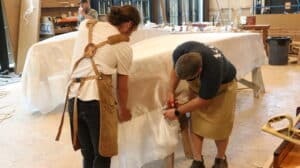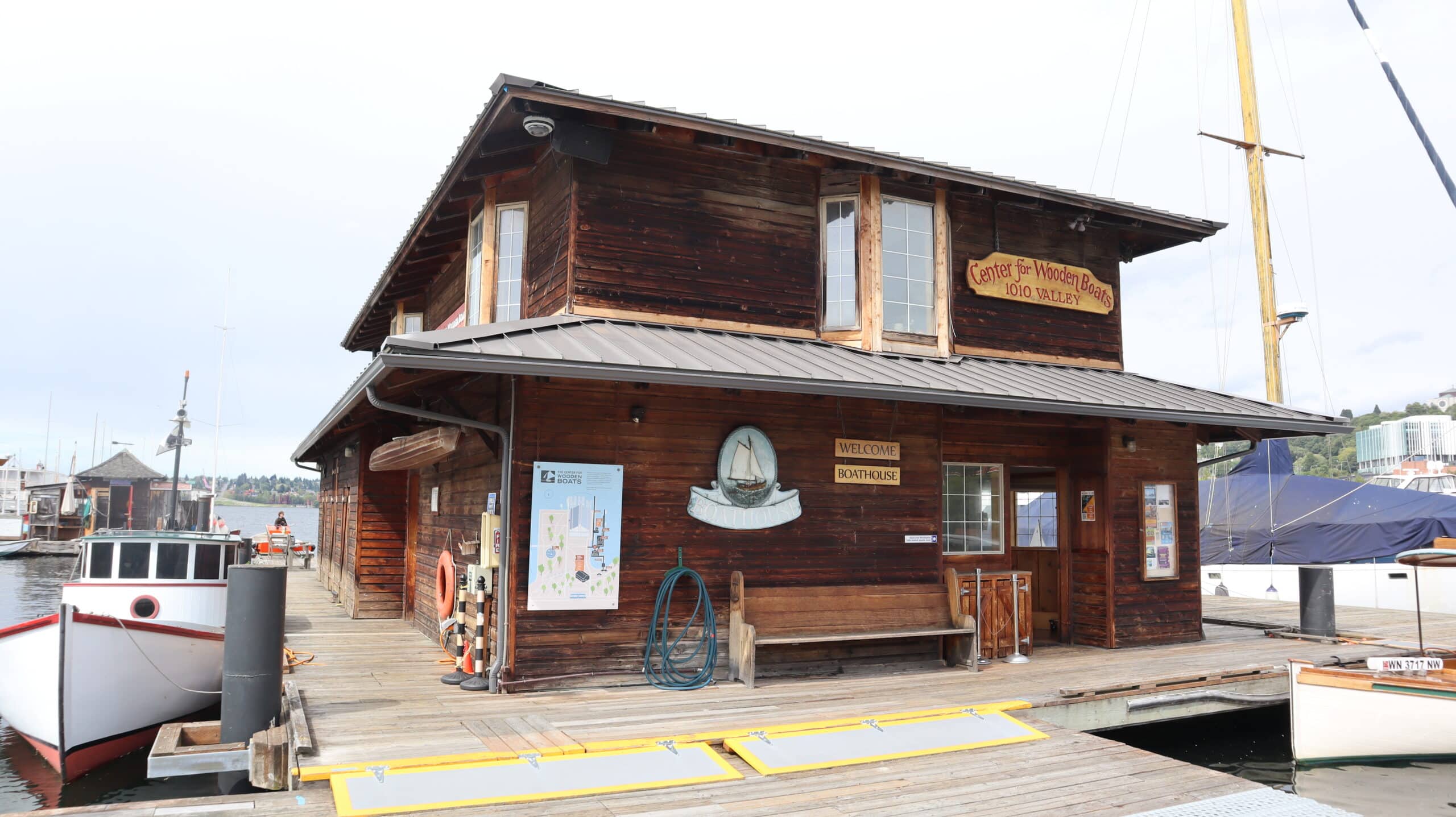National Heritage Areas are based on partnerships: bringing together a range of Tribes, organizations, businesses, and governments around heritage resources and stories. One of our partners is the Center for Wooden Boats. If you are interested in becoming a partner, learn more on our become a partner page.
Nestled on the southern shore of Lake Union stands the boatshed-like headquarters of the Center for Wooden Boats (CWB). Their South Lake Union Park home is adjacent to a myriad of maritime sites, including the Museum of History and Industry and the Historic Ships Wharf, but CWB is unique in the level of access to the water they provide to the community. There are few places where Seattle urbanites can get away from the concrete jungle, but with services including free wooden boat rentals, family-oriented programming, a longstanding speaker series, youth and women-centered boatbuilding and sailing programs, and much more, CWB serves dozens of needs for a diverse set of patrons.
In 1976, after the collapse of several regional boatbuilders, founders Dick and Colleen Wagner began accumulating a collection of boats beside their floating home under the Aurora Bridge. Now, CWB makes its home on the southern shore of the lake. Boats of different shapes and sizes hang from the ceiling over the lobby of the new Wagner Education Center, and the floating boathouses and docks that served as the home of the CWB for decades before the Center was built are on the water.
“Dick Wagner used to describe it as a petting zoo for boats,” said Josh Anderson, Executive Director of CWB. Josh jokes that “we’re the type of museum that purposely breaks its artifacts,” but contrary to Josh’s joke, there are no waterlogged or sinking ships here. The care the community has for this place is obvious from the way its visitors and volunteers handle the “exhibits” of this floating museum. Today, they’re getting ready for its next stage of life as CWB works towards renovation of the docks.



It Takes a Village
On the dock, some volunteers are getting ready for a boat restoration project. They stand near the “boat shop float,” where boats can be lifted directly out of the water via a small crane for quick and easy access to the hull–typically an expensive and difficult venture.
Vessels that need a little more care are taken to CWB’s facility on the north end of the lake next to the red pipes of Gasworks Park. There, some of the hundreds of volunteers who make up the impressive team at CWB can repair and restore boats to pristine condition before returning them to the South Lake Union headquarters.
“We have maybe 120 boats in the water,” said Josh. “Right now, everyone’s running around trying to get our little El Toro prams prepped for the upcoming summer classes.”
Back at the Wagner Education Center, a large garage-style door rolls up beside the front door, revealing several volunteers draping cloth over the hulls of two boats to coat them in fiberglass. In this space, workers have the resources to teach, build, and repair most things, all in public view.
Built by Volunteers
Only five of CWB’s staff went to any kind of formal boatbuilding school, said Josh. He counts himself among them, hailing from the Maine Maritime Academy in Castine, Maine. Most of their volunteer educators, docents, and boatbuilders learned their skills from CWB or another similar program.
“We get anywhere between 30 and 50 new volunteer prospects every single month,” said Josh. Those volunteers are trained, become part of the institution, and train other new volunteers. Volunteering with CWB also comes with other benefits, like free memberships and boat rentals.
The hybrid format between museum and experience is part of what makes CWB unique for volunteers. “You’re not coming here to just read static exhibits and learn about history. It’s more about volunteering and learning how to actually do that work,” said Josh. “We’re almost like a little shipyard: we have the docks; we maintain them. We have the boats; we maintain them ourselves, and then we integrate volunteers and the public or classes into all of it.”



Partnerships Across Sectors
Businesses across the maritime industry have been struggling to find and retain new staff. CWB hopes to address this challenge by engaging young people in maritime industries nationwide. “We’re a good entry point for young people getting into the maritime industry, whether it’s construction and trades or shipping or sail instruction, there’s so many angles to it all,” said Josh.
CWB also partners with other organizations engaged in maritime industries, like the Port Townsend Foundry, which supplies brass parts that cannot be made in-house. They have also recently partnered with former staff of the Northwest School of Wooden Boatbuilding to run classes on building a boat from scratch over the course of a year. While this type of programming has been the lifeblood of CWB for almost 50 years, it is not without challenges.
The Future of the Center for Wooden Boats
“It’s so incredibly complicated and expensive to maintain or restore or build anything over water, let alone like us on public land,” said Josh. To address this, CWB has begun a capital campaign to restore their docks. Predicted to cost $15 million, the renovation of the docks at CWB will increase access for people with disabilities, provide power further down the dock, increase protection against fire and storms, and ensure that their on-water facilities keep on floating.
According to Olive Theodore, Capital Campaign Manager for CWB, the actual cost of restoring the docks is only about two million dollars. Most of the expense is due to permitting and over-water safety. “We’re not doing anything without our docks, so there couldn’t be anything more important to us living out our mission than having those restored,” she says.
Olive wants to see CWB continue its work of increasing access to boats and the water. “We’re coming up on 50 years. We want to see 50 more,” said Olive. Josh agreed, saying, “It’s all just tied to that core mission of reducing barriers to people being able to get on the water.”
“CWB is just a little gem, especially in the city, and there aren’t a lot of other places in the country quite like it,” said Josh. “When you see firsthand how quickly a piece of maritime history and all that goes with it can get lost, it’s important… to connect people and keep it alive.”













